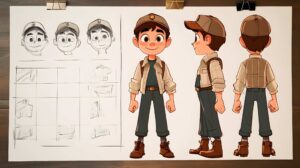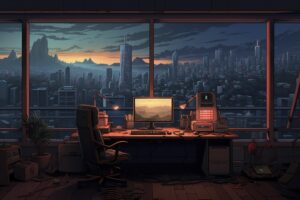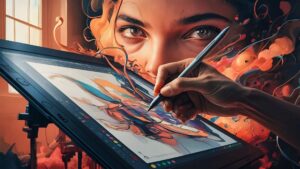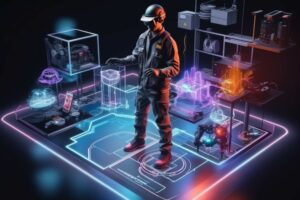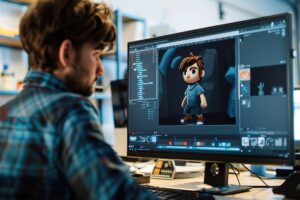
Top 7 Paid & Free Animation Software for Beginners
Top 7 Paid & Free Animation Software Tools for Beginners
Animation is pure magic where imagination takes form, drawings begin to move, and entire worlds are born from a single sketch. It’s the art of breathing life into still images, turning ideas into emotions and motion. From hand-drawn frames to 3D masterpieces, animation lets you tell stories that words alone never could.Whether you dream of working at Pixar or just want to create your own animated stories for fun, one question always comes first:“What animation software or Free Animation Software should I start with?”
The good news is you don’t need a Hollywood studio setup or a six-figure budget to begin. Today’s animation tools are smarter, more accessible, and surprisingly affordable (some even free!). From 2D sketch tools to 3D modeling powerhouses, this guide breaks down the top 7 animation software options for beginners each with its own flavor, focus, and creative vibe.
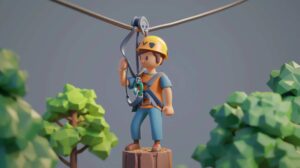
Blender is the ultimate underdog success story. What began as an open-source project is now a studio-grade 3D animation suite used by indie filmmakers and professionals alike.It handles everything modeling, texturing, rigging, sculpting, compositing, and even video editing all in one sleek platform. The best part is, it’s 100% free animation software, yet capable of creating Netflix-quality shorts (seriously, check out Next Gen and Sprite Fright).
Why Beginners Love It:
- A huge community means endless free tutorials.
- Frequent updates make it future-proof.
- It’s powerful enough to grow with your skills so you won’t “outgrow” Blender anytime soon.
If you’re serious about 3D animation but short on cash, Blender is where your journey begins.
2. Toon Boom Harmony – The 2D Industry Standard
Used in shows like Rick and Morty and The Simpsons, Toon Boom Harmony is what many studios rely on for high-end 2D animation. It’s designed for frame-by-frame artists who want that classic, hand-drawn charm with digital efficiency.It supports advanced rigging, compositing, and paperless animation workflows making it a dream tool for professionals and students alike.
Why Beginners Love It:
- Streamlined drawing tools feel natural.
- Built-in tutorials guide you step-by-step.
- You’ll be learning on the same platform studios use a serious résumé boost.
If you’re pursuing a professional animation career, Harmony is worth every rupee.
3. OpenToonz-Studio-Quality Animation for Free
Here’s a fun fact: OpenToonz is based on the same software used by Studio Ghibli for classics like Spirited Away and Howl’s Moving Castle. Yes, you read that right the legendary Ghibli animation pipeline is now available to everyone as Free Animation Software.
Why Beginners Love It:
- The interface is simple yet professional.
- Special effects libraries (like Ghibli’s custom effects) are built in.
- It runs smoothly even on average laptops.
OpenToonz might not have the polish of pricey tools, but it’s a gem for learners who value artistry over flashy features.
4. Adobe Animate-The Modern Face of Flash
Remember Flash cartoons from the early 2000s? Adobe Animate is its cooler, more capable descendant. It’s perfect for short-form content YouTube intros, educational explainers, or social-media animations.
Why Beginners Love It:
- Easy to use with familiar Adobe shortcuts.
- Integrates smoothly with Photoshop & Illustrator.
- Ideal for creators exploring animation for branding or content marketing.
If you’re a designer or digital artist wanting to dip into animation without learning complex 3D tools, Animate is your creative playground.
5. Krita -The Hidden Gem for Frame-by-Frame Artists
Originally a digital painting app, Krita now includes a robust animation timeline. It’s simple, fluid, and perfect for illustrators transitioning into animation.
Why Beginners Love It:
- Intuitive brush engine with real pencil textures.
- Clean interface, no tech overwhelm.
- It’s open source and runs on nearly any system.
Krita’s not for heavy compositing or effects, but if you want to draw and animate your own characters, it’s delightfully hands-on.
6. Autodesk Maya -The Professional 3D Standard
For decades, Maya has been the gold standard in 3D animation. From Frozen to Spider-Man: Across the Spider-Verse, it powers blockbuster visuals. While it can be intimidating at first, learning Maya is almost a rite of passage for serious animators.
Why Beginners Love It:
- Industry benchmark – mastering it opens doors.
- Student licenses are free.
- Advanced rigging and physics tools for next-level realism.
Maya demands patience, but the payoff is huge. It’s like learning the language of the pros.
7. Moho (Anime Studio) -Perfect for Aspiring Cartoonists
Moho strikes a perfect balance between power and simplicity. It lets you rig 2D characters with bones so instead of redrawing every frame, you can make your characters move smoothly, puppet-style.
Why Beginners Love It:
- Easy rigging saves tons of time.
- Clean timeline and vector tools.
- Affordable pricing and beginner-friendly learning curve.
If you’re into character-based storytelling or YouTube-style animations, Moho’s playful interface will keep you hooked for hours.
How to Choose the Right Software for You
Still not sure where to begin? Think about your goals. The right animation software depends on what you want to create. If your dream is to master 3D animation, tools like Blender or Maya are perfect for you. They’re powerful, professional, and grow with your skills. For those who love crafting 2D cartoons, Toon Boom Harmony and Moho offer smooth workflows built for expressive character animation. If you prefer a more artistic, hand-drawn approach, Krita or OpenToonz let you draw and animate frame-by-frame with ease—and they’re free to use. And if your focus is web or YouTube animation, Adobe Animate shines with its seamless tools for motion graphics and digital storytelling.
If you’re serious about building a career in this field, consider enrolling in a Top Animation College in Bangalore where you can learn from industry experts, gain practical experience, and bring your creative visions to life.
Pro Tip: Don’t hesitate to experiment. Every program has its own “feel.” Try a few, and you’ll quickly discover which one matches your creative rhythm.
Trends Shaping Animation Software in 2025
Animation tech isn’t standing still. Here’s what’s reshaping the field:
AI Assisted Workflows
AI tools now predict in-between frames, clean up sketches, and even suggest camera angles. Instead of replacing artists, they’re cutting repetitive work, letting animators focus on storytelling.
Cloud Collaboration
Platforms like SyncSketch and Ftrack make it easy for remote teams to co-create. Expect most software to integrate live collaboration soon.
Mobile Animation Apps
Procreate Dreams and RoughAnimator are bringing real animation to tablets proving you don’t need a studio PC to animate beautifully.
Real-Time Engines
Unreal Engine and Unity are being used not just for games but for full-fledged animated films. The lines between gaming and filmmaking continue to blur.
Beginner’s Roadmap to Learn Animation
Starting out can feel overwhelming, so take it step by step:
- Pick Your Tool: Choose one software from this list and stick to it for at least 3 months.
- Start Small: Animate a bouncing ball, then a walk cycle. Don’t rush to create a short film.
- Study Reference: Watch classic animation frames movement is about observation, not speed.
- Join Communities: Reddit’s r/animation, ArtStation, and YouTube channels like Howard Wimshurst are gold mines for feedback.
- Build a Portfolio: Save your mini-projects; they’ll become the backbone of your demo reel.
How LISAA Nurtures Future Animators
While the right tools are important, mastering animation also requires structured guidance and that’s where institutions like LISAA School of Design, Bangalore step in.From 2D and 3D animation to storytelling, cinematography, and visual effects, the LISAA Animation course mirrors real industry workflows. Students get hands-on experience with professional software like Blender, Maya, Toon Boom Harmony, and Adobe Animate, the same tools used by top studios worldwide.
The 30,000 sq. ft. Bangalore campus is equipped with state-of-the-art labs, film studios, and creative spaces that encourage experimentation and innovation. What makes LISAA stand out is its mentorship-driven learning approach. Every student receives personal guidance from experienced professionals who understand both art and the animation industry.With workshops, live projects, and international collaborations, LISAA students graduate with not just a degree but a portfolio ready for global opportunities. It’s where passion meets profession, and creativity becomes a career.
Final Thoughts: Your First Frame Matters Most
Animation isn’t just about mastering software; it’s about patience, observation, and the endless curiosity to breathe life into your imagination. The tools are only your brushes the true art lies in how you see, feel, and express movement. And if you’re just starting out, try Blender one of the best Free Animation Software options to bring your ideas to life.
Every great animator begins not with perfection, but with passion a single sketch that grows into a masterpiece through persistence and creativity. So whether you’re sculpting 3D worlds in Blender, sketching expressive 2D characters in Krita, or learning the language of storytelling at LISAA School of Design, remember this: every frame you create is a reflection of your growth.Keep experimenting, keep observing, and most importantly keep animating. Because one day, that simple bouncing ball you start with might just become the spark that shapes an entire world on screen.
